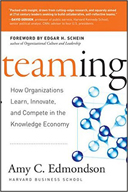- Home
- Articles
- Reviews
- About
- Archives
- Past Issues
- The eLearn Blog
Archives
| To leave a comment you must sign in. Please log in or create an ACM Account. Forgot your username or password? |
|
Create an ACM Account |

Amy Edmondson was one of the three authors who wrote on learning organization dimensions in a way I found really insightful, and I regularly use their model as the basis for a learning culture. Now she's come out with book on teaming, and I think it nicely says things that my Internet Time Alliance (ITA) colleagues and I have been saying for quite a while.
Subtitled "How organizations learn, innovate, and compete in the knowledge economy," this book takes Edmondson's years of research into organizational success and distills down the results into some straightforward models. Her messages resonate quite strongly; she talks about the need to move away from Taylorism to more egalitarian models of management that tap into the power of people. She also comes up with the actions leaders need to take to get there.
Edmondson starts with an analysis of organizational processes, characterizing a continuum from routine execution, through complex problem-solving, to innovation in new areas. The structure bears some resemblance to Dave Snowden's Cynefin model. Edmondson acknowledges all organizations have pockets of all three processes, but you need to apply the right approach to the right situations. She returns to the structure to illustrate how her overall recommendations get mapped differently into each domain.
She also makes a strong case that teams are the necessary structure at which organizations need to be thinking for learning and innovation. She talks about how individuals are unlikely to be the source for the necessary cross-pollination that will support a generation of new ideas and solutions. This mimics messages we've heard from Keith Sawyer and Stephen Johnson that debunk the myth of the individual innovator.
From there, Edmondson goes on to the core behaviors that organizations need to exhibit. She explains teams need people to speak up (not holding on to thoughts), collaborate, experiment, and reflect. These are known elements required in research, problem solving, design, and more, but again her examples and prose are clear.
The important point Edmondson gets to is the four steps leaders need to take to enable these critical behaviors. First, leaders making a conscious shift from execution to learning should illuminate the ways in which rote execution stifle creativity. She also says they must make it safe to speak out, which is challenging but critical. A third point is the organization must accept mistakes as part of the cost of doing business. The types and scope change across the spectrum of processes, but in all cases things must be tested. Finally, she points out that it's critical to work across silos, getting communication going in ways that transcend the natural business barriers.
This isn't new, as it reflects arguments on new organization structure, culture, and needs to innovate. What is new is that the book is nicely presented, written by a Harvard Business School faculty member, and well illustrated. This is definitely part of the needed moves to more successful organizations, and it's joining my L&D revolution reading list.
Recommended.
Clark Quinn, Ph.D., helps organizations use technology aligned with how we think, work, and learn to achieve better outcomes. An internationally known consultant, Dr. Quinn has authored four books on learning technology and keynotes regularly. He previously taught at the University of New South Wales and has served in leadership positions in several new media and learning organizations. Clark works with Fortune 500 companies, education, government, and the not-for-profit sectors through Quinnovation, tweets as @quinnovator, and blogs at learnlets.com.
Permission to make digital or hard copies of part or all of this work for personal or classroom use is granted without fee provided that copies are not made or distributed for profit or commercial advantage and that copies bear this notice and the full citation on the first page. Copyrights for third-party components of this work must be honored. For all other uses, contact the Owner/Author.
2015 Copyright held by the Owner/Author. 1535-394X/16/05-2936729 $15.00
|
To leave a comment you must sign in. |
|
Create an ACM Account. |